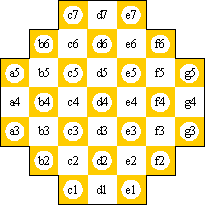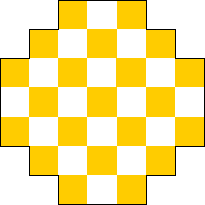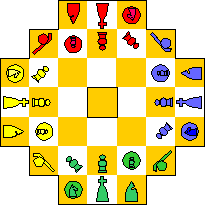Hans37 Chess
INDEX:
Basic Premise
In April 1997, on the page http://www.chessvariants.com/d.chessvar/whatsnew.html, I see the text "Can you think up a nice chess variant that can be played on this board by way of birthday present?"
Formal Rules
This is a four-player game. Well, it looks like a four-player board to me! The object of the game is to get your King to the center square and keep it there for more than one turn; if your King is on the center square, and it is your move, and you don't have to move the King, and you are not in checkmate or stalemate, you win.
Each of the four players has the same set of pieces. I will describe the South starting position, but all are symmetrical.
South's King starts on d1. Where is d1? Oops. Here's an ASCII idea of the board with notation:
XX XX c7 d7 e7 XX XX XX b6 c6 d6 e6 f6 XX a5 b5 c5 d5 e5 f5 g5 a4 b4 c4 d4 e4 f4 g4 a3 b3 c3 d3 e3 f3 g3 XX b2 c2 d2 e2 f2 XX XX XX c1 d1 e1 XX XX
So, the center square is d4, the Kings start on d1 (South), g4 (East), d7, (North), and a4 (West).

Check must be respected, but if you are checkmated you merely cannot move. If the checkmate is released, you can move again. The King may not be captured.
South has one Berolina Pawn, that starts the game on c2. (Berolina Pawns move diagonally forward, capture straight forward). If it reaches c7, d7, or e7, it promotes into a Wazir (moves one square Rookwise).
South has one Shatranj Pawn, that starts on d2. (A Shatranj Pawn moves like a normal chess pawn but has no possibility to make a double step on its first move.) If it reaches c7, d7, or e7, it promotes into a Ferz (Moves one square diagonally).
South has one Chinese Pawn, that starts on e2. (A Chinese Pawn moves and captures one square straight ahead.) If it reaches the fifth rank (or further) it gains the power of moving sideways.
Pawns have no initial double-step.
South has one Dabaaba on f2; this piece jumps two squares Rookwise: from f2 it defends d2 (even though there is something on e2), and attacks f4.
South has a Chinese KnightRider on c1. This piece moves like a Knight, except that it cannot jump over any obstacles (from c1 to d3, but not if c2 is occupied), and then if the square it reached was empty, it can continue (from d3 to e5). Because of the shape of the board, this piece can never move farther than two Knight moves.
Last of all, South has a very short Bishop on e1. This piece can go no farther than two squares at a time.
South plays first, then West, North, and East.
Strategy Ideas
The board is very crowded, but the pieces are weak.
The rules are pleasantly exotic.
Variants
Either all four players are independent, or they form two teams, North-South versus East-West.
Puzzle and Problem
Find the shortest game.
A solution with 16 moves (4 turns) was found by Alfred Pfeiffer.
Written by Ralph Betza, as a birthday present for Hans Bodlaender.
WWW page created: April 23, 1997.

